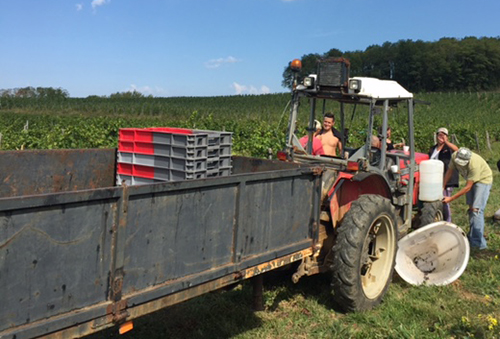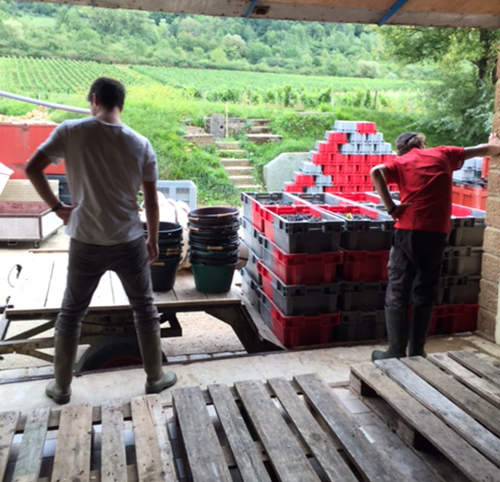Wine’s romantic journey from the vine to the table is part of what inspires people to pursue a career in sommellerie. But it’s all too easy to over-idealize the subject of wine and over-simplify the steps involved in making it without having engaged in the production side of the business at least once. Most sommeliers reside in metropolitan areas that can support restaurants with serious wine programs – yet wine is produced in agricultural zones, some of the most important of which are literally thousands of miles from home. While reading, logging cellar hours, and tasting as frequently as possible are vital to cultivating a theoretical knowledge of wine, some things can’t be learned in a book or passed down through the oral tradition of on-the-job mentoring. Enter the harvest internship. It’s the best way to truly internalize the realities of winemaking. You develop not only a greater appreciation for the work of the winemaker, but a deeper understanding of the processes involved and a better sense of our visceral connection to the land and the rhythms of nature. Plus, the winemaker will greatly appreciate your help at the time of the year when it is most needed.
It’s common knowledge that winemaking is a very physical job. After all, it’s farming – and that in itself requires long hours of toiling in the field. But after the crop comes in, there’s the additional responsibility of transforming it through carefully guided maceration (for red) and pressing (for white), both of which are time-sensitive, since picked fruit left in the open air too long risks oxidation, and if fermentation kicks off before you’re ready for it, other unpleasant aromas can ensue. On paper, it sounds like a lot of work, but only after putting in several fifteen-hour days do you really have a sense of the toll it can take on the body. During picking, you feel it primarily in your legs and lower back. A lot of ground is covered to fill each tank, and picking is really a series of consecutive squats over many hours. In the winery, each tank requires constant monitoring, with pump-overs for reds utilizing a great amount of upper body strength – sometimes three times per day up until devatting – and a tolerance for inhaling the large gusts of CO2 gas that inevitably come your way.
Harvest is messy business. Your hands will end up scraped and sappy, but there’s something deeply satisfying about seeing the dirt under your fingernails and knowing that you put in a hard day’s work.
Then, there’s the cleaning. “Cleaning is ninety percent of winemaking,” I overheard Emmanuelle Perraut, cellarmaster at Domaine de la Pinte, say during this year’s harvest in Arbois (Jura), and she wasn’t exaggerating. Harvest is messy business. Your hands will end up scraped and sappy, but there’s something deeply satisfying about seeing the dirt under your fingernails and knowing that you put in a hard day’s work. The resulting fruit – skins, juice, and stems, will end up caked all over the walls, the floor, the destemmer, and the conveyer belt. All of that has to be hosed down and pristine between usages. Tanks have to be thoroughly washed before and after receiving their fill, and that often requires climbing inside to clear away any residue from interior walls. It’s one thing to extol the importance of great sanitary conditions at a winery; it’s another to be tasked with keeping that winery clean.

Just visiting producers can be a great way to further your understanding of the inner workings of a winery, but rarely do ‘aha’ moments occur without hands-on experience. It’s the reason that chemistry and biology lessons in school were always supplemented with a lab – to add a dimension of tangibility to a concept. One such instance from my personal harvest experience that will remain forever engrained in my memory was snagging a grape undergoing intrapellicular fermentation from the tank and eating it. (Intrapellicular, or “whole berry”, fermentation is the natural process that occurs inside the whole, uncrushed berry, during carbonic or semi-carbonic maceration.) Though I had theoretically grasped the idea, actually tasting the intact berry transforming from the inside out on my palate was a surprising sensation – tingly and retro-nasally perfumed, the grapey-ness having already transformed into a whole myriad of bright fruit flavors. The experience reminded me of seeing the inside of a piano for the first time as a child – watching the tiny hammers hit the strings, music vibrating out. I got it. Tasting the juice in general through its many stages of fermentation is illuminating, the flavors changing and evolving from one day to the next, all based on chemical properties and reactions that we abstractly know. But firsthand sensorial experience of them can take that knowledge to a new level.
Though I had theoretically grasped the idea, actually tasting the intact berry transforming from the inside out on my palate was a surprising sensation. The experience reminded me of seeing the inside of a piano for the first time as a child – watching the tiny hammers hit the strings, music vibrating out. I got it.

One of the challenges of working harvest is the time commitment. Depending on the size of the estate, how evenly everything ripens, and if there are late harvest sweet wines in the equation, harvest can last two months. For a sommelier, that leave requires either a very sympathetic boss or taking a professional sabbatical between jobs. Thomas Pastuszak, Wine Director at The NoMad Hotel in New York, wanted to find a better solution. “I wanted my sommeliers to have the full-fledged experience, but I thought, ‘how can we do this in a way that I don’t lose my team for weeks at a time?’” he says. He launched a collaboration project with the Hermann J. Weimer Vineyard in New York’s Finger Lakes and this year sent two sommeliers from NoMad and two sommeliers from Eleven Madison Park up at a time for three-day stints once a week over their four-week harvest period. That equates to sixteen lucky sommeliers that were able to participate. “Monday morning, they jump in a car and are at Seneca Lake by 12:30 or 1:00,” he says. “They have a couple of harvest meals together, put in some hard work, and drive back Wednesday morning to be ready for service Wednesday night. In a matter of 48 hours, they get a real sense of what goes on at a winery during harvest.”
For anyone whose restaurant doesn’t have a harvest program like NoMad’s, a simple search on Google or WineJobs.com can connect sommeliers to hundreds of wineries around the country seeking seasonal interns. But my best advice is to reach out to a winemaker that you already have good rapport with – someone that you’ve met while visiting the region or who has been through your restaurant a few times on market trips. You’ll want to work with someone who you know will go out of his or her way to truly show you the ropes and make sure you don’t miss any potential valuable lessons. In Europe, it will require sponsorship for a visa for a paid internship or a winemaker who is comfortable taking on the risk of undocumented and (likely) unpaid help. Being outdoors, away from the concrete jungle and absorbing the bigger picture sensation that what you’re doing is real – that wine is a series of reactions to what nature has produced – is another tremendous benefit. Feeling the climatic conditions of a vintage by working in them is the surest way to imprint the ‘somewhereness’ that we define as terroir. You’ll end up wet, tired, sore, callused, and feeling totally reinvigorated about your industry.
